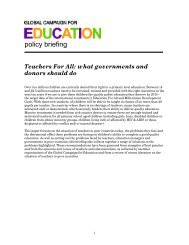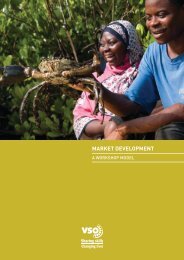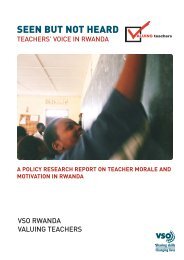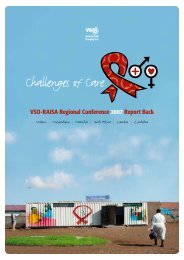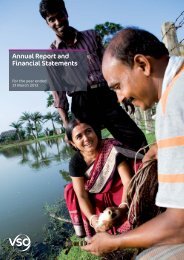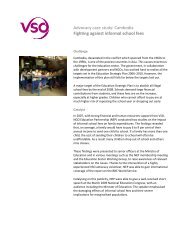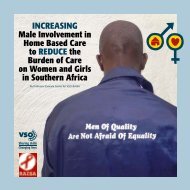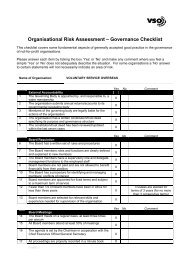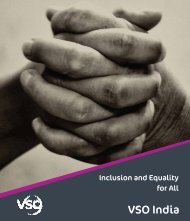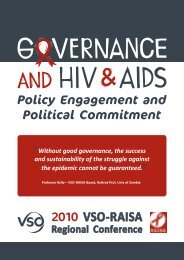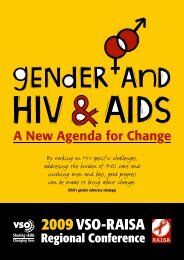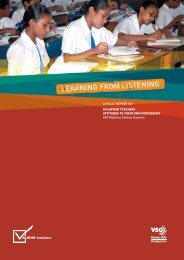Walking the Talk - VSO
Walking the Talk - VSO
Walking the Talk - VSO
Create successful ePaper yourself
Turn your PDF publications into a flip-book with our unique Google optimized e-Paper software.
Box 2. The Climbing to Manhood Project, Chogoria hospital, KenyaIn Kenya, <strong>the</strong> Climbing to Manhood Project of Chogoria hospital uses <strong>the</strong> practice of circumcision, a traditionalrite of passage, to address issues around young men’s sense of manhood and masculinity. During <strong>the</strong> time ofcircumcision around <strong>the</strong> age of 15, boys are expected to undergo physical, psychological and behaviouralchanges associated with manhood, and may be encouraged to begin having sexual relations. Chogoria hospitalrecognised <strong>the</strong> time around this ceremony as an opportunity to inform boys about sexual health. Incorporating<strong>the</strong> seclusion and bonding that occur as part of traditional circumcision rites, groups of boys participating in <strong>the</strong>project spend a week toge<strong>the</strong>r in a special ward following hospital circumcision. Men from <strong>the</strong> communityincluding healthcare workers, pastors and teachers explore a range of topics with <strong>the</strong>m including STIs and HIVand AIDS, community expectations of men, and issues surrounding violence. 92musicians as good sources of HIV-prevention messages. 84In South Africa, women mentioned Soul City and Lovelife,TV programmes that have been targeting youth with HIVpreventioninformation. Soul City has in fact been verysuccessful in its outreach and replication in o<strong>the</strong>r countriesof <strong>the</strong> region, including <strong>the</strong> creation of school clubs.International donors, including DFID, fund <strong>the</strong> project andit provides a clear case of good practice. Governmentsand donors should fund additional and large-scaleprogrammes that raise awareness of HIV prevention with<strong>the</strong> participation of women and girls. These campaignsmust go hand in hand with programmes challenginggender norms so that women and girls’ knowledge aboutHIV and AIDS is accompanied by <strong>the</strong> necessary power tonegotiate safer sex.Public campaigns must also reflect women’s rights, <strong>the</strong>need for women’s empowerment and women’sleadership in order to be effective. The ABHAYA projectin India, for example, raises awareness amongvulnerable and excluded groups of <strong>the</strong>ir rights andentitlements. The project has had substantial successbasing HIV-prevention messages on women’s rights. Asone sex worker explained:“Here I learnt that if we sex workers unite, we willbe able to get our rights. We talked aboutviolence and how we can protect ourselves fromviolence, and that we have <strong>the</strong> right to askquestions. I come to ABHAYA for <strong>the</strong> monthlysupport group meetings and visit <strong>the</strong> STI clinicregularly. I have also learnt about safe sex andHIV and AIDS after coming here and have startedinsisting on using condoms ever since.” 85However, among <strong>the</strong> women interviewed for thisresearch, this experience seems to be <strong>the</strong> exceptionra<strong>the</strong>r than <strong>the</strong> rule. Many women and girls remainunaware of <strong>the</strong>ir rights. Some members of a focusgroup of women living with HIV and AIDS inBangladesh, for example, argued that women are“usually unaware of <strong>the</strong>ir basic rights”. 86 For o<strong>the</strong>rrespondents, women seemed to be “programmed froman early age to think of <strong>the</strong>mselves as unequal and thus<strong>the</strong>y are not aware of <strong>the</strong>ir rights as individuals”. 87Finally, women and girls’ access to HIV preventioninformation and services often lies in <strong>the</strong> hands ofhusbands, fa<strong>the</strong>rs, community leaders and serviceproviders who play <strong>the</strong> role of gatekeepers. For example,women and girls are often deliberately left in <strong>the</strong> darkregarding <strong>the</strong>ir husband’s HIV status as well as <strong>the</strong>ir own.One focus group in Bangladesh reported cases of womenwhose husbands had infected <strong>the</strong>m knowingly andsubsequently refused <strong>the</strong>m or <strong>the</strong>ir children an HIV test. 88“When a male is identified as positive, it oftentakes considerable convincing and coercing for<strong>the</strong>m to get <strong>the</strong>ir families tested” [and <strong>the</strong>husband] “always makes that decision.” 89To resolve this, one focus group participant in Nigeriaemphasised that:“Messages should be made in such a way that<strong>the</strong>y give power to women to freely makechoice[s] and take decisions on usage ofprevention tools like condom[s].” 90In particular, community awareness-raising initiativesneed to be long-term, strategic and sustainable. 91 Theyneed to enable women to increase <strong>the</strong>ir participation,power and equality in <strong>the</strong> community and familyspheres, lead men to act responsibly and respect <strong>the</strong>irwives’ rights, and enable women and girls to share<strong>the</strong>ir positive status publicly without violence, stigmaand discrimination.<strong>Walking</strong> <strong>the</strong> talk putting women's rights at <strong>the</strong> heart of <strong>the</strong> HIV and AIDS response 23



